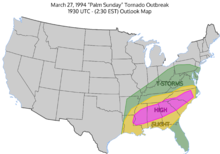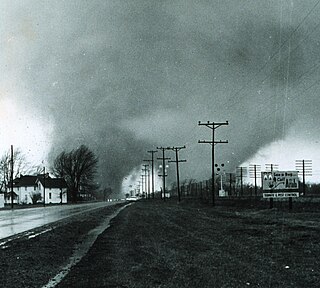
On April 10–12, 1965, a devastating severe weather event affected the Midwestern and Southeastern United States. The tornado outbreak produced 55 confirmed tornadoes in one day and 16 hours. The worst part of the outbreak occurred during the afternoon hours of April 11 into the overnight hours going into April 12. The second-largest tornado outbreak on record at the time, this deadly series of tornadoes, which became known as the 1965 Palm Sunday tornado outbreak, inflicted a swath of destruction from Cedar County, Iowa, to Cuyahoga County, Ohio, and a swath 450 miles long (724 km) from Kent County, Michigan, to Montgomery County, Indiana. The main part of the outbreak lasted 16 hours and 35 minutes and is among the most intense outbreaks, in terms of tornado strength, ever recorded, including at least four "double/twin funnel" tornadoes. In all, the outbreak killed 266 people, injured 3,662 others, and caused $1.217 billion in damage.
On April 5–6, 1936, an outbreak of 14 tornadoes struck the Southeastern United States, killing at least 454 people and injuring at least 2,500 others. Over 200 people died in Georgia alone, making it the deadliest disaster ever recorded in the state.

On March 28, 1920, a large outbreak of at least 37 tornadoes, 31 of which were significant, took place across the Midwestern and Southern United States. The tornadoes left at least 153 dead and at least 1,215 injured. Many communities and farmers alike were caught off-guard as the storms moved to the northeast at speeds that reached over 60 mph (97 km/h). Most of the fatalities occurred in Georgia (37), Ohio (28), and Indiana (21), while the other states had lesser totals. Little is known about many of the specific tornadoes that occurred, and the list below is only partial.
On February 19–20, 1884, one of the largest and most widespread tornado outbreaks in American history occurred over the Southeastern United States, known as the Enigma tornado outbreak due to the uncertain number of total tornadoes and fatalities. Nonetheless, an inspection of newspaper reports and governmental studies published in the aftermath reveals successive, long-tracked tornado families striking Alabama, Georgia, Illinois, Indiana, Kentucky, Mississippi, North Carolina, South Carolina, Tennessee and Virginia, with an estimation of at least 52—and possibly 60 or more—tornadoes.
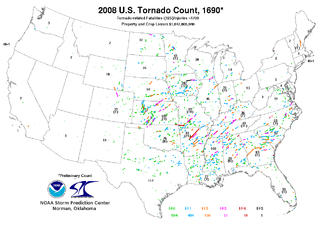
This page documents notable tornadoes and tornado outbreaks worldwide in 2008. Strong and destructive tornadoes form most frequently in the United States, Bangladesh, and Eastern India, but they can occur almost anywhere under the right conditions. Tornadoes also develop occasionally in southern Canada during the Northern Hemisphere's summer and somewhat regularly at other times of the year across Europe, Asia, and Australia. Tornadic events are often accompanied with other forms of severe weather, including strong thunderstorms, strong winds, and hail.
On March 21–22, 1952, a severe tornado outbreak generated eleven violent tornadoes across the Southern United States, which is the fourth-largest number of F4–F5 events produced by a single outbreak. Only the 1965 Palm Sunday tornado outbreak, the 1974 Super Outbreak, and the 2011 Super Outbreak surpassed this number. The outbreak caused 209 fatalities–50 of which occurred in a single tornado in Arkansas. The severe weather event also resulted in the fourth-largest number of tornado fatalities within a 24-hour period since 1950.

On February 21–22, 1971, a devastating tornado outbreak, colloquially known as the Mississippi Delta outbreak, struck portions of the Lower Mississippi and Ohio River valleys in the Southern and Midwestern United States. The outbreak generated strong tornadoes from Texas to Ohio and North Carolina. The two-day severe weather episode produced at least 19 tornadoes, and probably several more, mostly brief events in rural areas; killed 123 people across three states; and wrecked entire communities in the state of Mississippi. The strongest tornado of the outbreak was an F5 that developed in Louisiana and crossed into Mississippi, killing 47 people, while the deadliest was an F4 that tracked across Mississippi and entered Tennessee, causing 58 fatalities in the former state. The former tornado remains the only F5 on record in Louisiana, while the latter is the deadliest on record in Mississippi since 1950. A deadly F4 also affected other parts of Mississippi, causing 13 more deaths. Other deadly tornadoes included a pair of F3s—one each in Mississippi and North Carolina, respectively—that collectively killed five people.
The 1956 McDonald Chapel tornado was a deadly weather event that took place during the afternoon of April 15, 1956, across the Greater Birmingham area in Jefferson County, Alabama, with damage most severe in McDonald Chapel. The F4 tornado killed 25 people and injured 200 others. While only two known tornadoes touched down across the Southeastern United States on that day, the Birmingham tornado produced major devastation across areas west and north of downtown Birmingham.
On March 21–22, 1932, a deadly tornado outbreak struck the Midwestern and Southern United States. At least 38 tornadoes—including 27 deadly tornadoes and several long-lived tornado families—struck the Deep South, killing more than 330 people and injuring 2,141. Tornadoes affected areas from Mississippi north to Illinois and east to South Carolina, but Alabama was hardest hit, with 268 fatalities; the outbreak is considered to be the deadliest ever in Alabama, and among the worst ever in the United States, trailing only the Tri-State tornado outbreak in 1925, with 751 fatalities, and the Tupelo–Gainesville outbreak in 1936, with 454 fatalities. The 1932 outbreak is believed to have produced 10 violent tornadoes, eight of which occurred in Alabama alone.

A long-lived tornado outbreak sequence affected the Southern Plains, the southeastern and Middle Atlantic region of the United States from May 7–11, 2008. The storm produced 120 confirmed tornadoes starting on May 7 and lasting until late on May 11. The outbreak sequence killed 28 people across several states; 25 were killed by tornadoes. The event occurred less than a week after a deadly tornado outbreak that principally affected the state of Arkansas and killed 7 people.
A deadly tornado outbreak affected much of the central and Southern United States from April 29–May 1, 1909. Affecting particularly the Mississippi and Tennessee Valleys, it killed over 150 people, 60 of them in the U.S. state of Tennessee alone. The deadliest and longest-tracked tornado of the outbreak was a violent F4 tornado family that tracked across portions of western Tennessee on April 29, claiming at least 29 lives. Another deadly F4 tornado struck portions of northern Alabama and southern Tennessee early the next day, killing the same number. Other F4s in southern Missouri and southern Illinois on April 29 killed a combined 16 people. Deadly F3s in Georgia and Tennessee from April 30–May 1 killed a total of at least 53 people as well.
On April 29–30, 1924, an outbreak of at least 28 tornadoes—26 of which were significant, meaning F2 or stronger—affected the Southern United States. The tornadoes left 114 dead and at least 1,166 injured, mostly in the Carolinas, with 76 deaths in South Carolina alone, along with 16 in Georgia and 13 in Alabama. Killer tornadoes touched down from Oklahoma and Arkansas to Virginia. The deadliest tornado of the outbreak was a long-lived tornado family that produced F4 damage in rural portions of South Carolina, killing 53 people and injuring at least 534. The tornado is the deadliest ever recorded in South Carolina and is one of the longest-tracked observed in the state, having traveled 105 miles (169 km); some sources list a total path length of 135 mi (217 km), including the segment in Florence County, but this is now believed to have been a separate, F3 tornado.
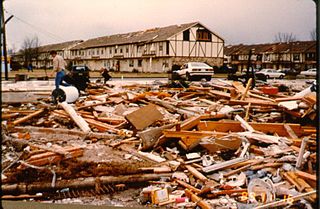
This page documents the tornadoes and tornado outbreaks of 1989, primarily in the United States. Most tornadoes form in the U.S., although some events may take place internationally. Tornado statistics for older years like this often appear significantly lower than modern years due to fewer reports or confirmed tornadoes.
On April 19–21, 1920, a multi-day severe weather event affected the Southeastern United States. The most intense portion of the outbreak occurred on the morning of April 20. At least seven tornadoes affected the American U.S. states of Mississippi, Alabama, and Tennessee, six of them rated violent F4s on the Fujita scale. The tornado outbreak killed at least 243 people.
On December 18–20, 1957, a significant tornado outbreak sequence affected the southern Midwest and the South of the contiguous United States. The outbreak sequence began on the afternoon of December 18, when a low-pressure area approached the southern portions of Missouri and Illinois. Supercells developed and proceeded eastward at horizontal speeds of 40 to 45 miles per hour, yielding what was considered the most severe tornado outbreak in Illinois on record so late in the calendar year. Total losses in the state were estimated to fall within the range of $8–$10 million.
The March 1875 Southeast tornado outbreak was a deadly tornado outbreak that affected portions of the Southern United States from March 19–20, 1875. At least 19 tornadoes were recorded, including seven that were destructive enough to be rated F4 by Thomas P. Grazulis. The worst damage and most of the deaths occurred in Georgia. Most of the damage appears to have been the result of two tornado families that moved along parallel paths 12 to 15 mi apart through parts of Georgia and South Carolina. These families each consisted of numerous long-tracked, intense tornadoes. The deadliest tornado of the outbreak was an estimated F4 that killed 28–42 people in and near Sparta, Georgia, and Edgefield, South Carolina, on March 20. A separate F4 that followed a similar trajectory may have killed as many as 30. In all, this outbreak killed at least 96 people, injured at least 377, and caused at least $650,000 in losses.
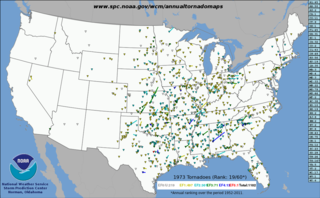
This page documents notable tornadoes and tornado outbreaks worldwide in 1973, but mostly features events in the United States. According to tornado researcher Thomas P. Grazulis, documentation of tornadoes outside the United States was historically less exhaustive, owing to the lack of monitors in many nations and, in some cases, to internal political controls on public information. Most countries only recorded tornadoes that produced severe damage or loss of life. Consequently, available documentation in 1973 mainly covered the United States. On average, most recorded tornadoes, including the vast majority of significant—F2 or stronger—tornadoes, form in the U.S., although as many as 500 may take place internationally. Some locations, like Bangladesh, are as prone to violent tornadoes as the U.S., meaning F4 or greater events on the Fujita scale.

This page documents the tornadoes and tornado outbreaks of 1954, primarily in the United States. Most tornadoes form in the U.S., although some events may take place internationally. Tornado statistics for older years like this often appear significantly lower than modern years due to fewer reports or confirmed tornadoes.
A widespread, destructive, and deadly tornado outbreak sequence affected the Southeastern United States from April 28 to May 2, 1953, producing 24 tornadoes, including five violent F4 tornadoes. The deadliest event of the sequence was an F4 tornado family that ravaged Robins Air Force Base in Warner Robins, Georgia, on April 30, killing at least 18 people and injuring 300 or more others. On May 1, a pair of F4 tornadoes also struck Alabama, causing a combined nine deaths and 15 injuries. Additionally, another violent tornado struck rural Tennessee after midnight on May 2, killing four people and injuring eight. Additionally, two intense tornadoes impacted Greater San Antonio, Texas, on April 28, killing three people and injuring 20 altogether. In all, 36 people were killed, 361 others were injured, and total damages reached $26.713 million (1953 USD). There were additional casualties from non-tornadic events as well, including a washout which caused a train derailment that injured 10.

On the afternoon of March 3, 2019, a violent and long-tracked EF4 tornado struck portions of eastern Alabama and western Georgia, causing extreme damage along its path. This tornado was the deadliest tornado in the United States since the 2013 Moore tornado, killing 23 and injuring 97. This tornado was part of a larger tornado outbreak that affected the Southeastern United States on this same day. This outbreak produced numerous tornadoes across Alabama and Georgia. This was the deadliest and strongest tornado of this outbreak, and the 8th deadliest in Alabama state history.

